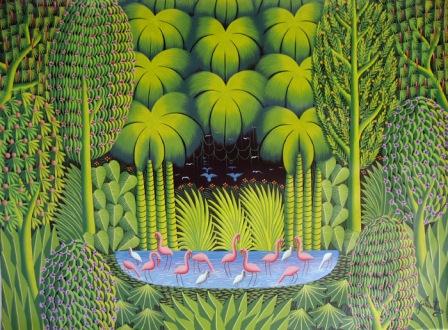
Joel Gauthier: Night in Eden Jungle (2007)
 Joel Gauthier: Night in Eden Jungle (2007) |
| < A new Garden of Eden > |
| How to populate a space station travelling far away in empty tranquility, left to nothing but sunlight? We have a circadian lighting cycle, we have (tiny) gravity, we have soil, we have insolation with higher energy than on the surface of the Earth, and we can recycle water to 100% - nothing is allowed to escape into space from our tight habitat. What else could any humble gardener wish for? There is a last wish: absence of pests! |
| And also this last wish should be easy to fulfil. By strictly controlling all material brought into the station, it should be possible to grow potatoes in a world without potato beetles, apples and cherries in a world without worms, grape vine in a world without Phylloxera lice, and to raise bees in a world without Varroa mites (it is, however, unknown whether bees will fly and build hives without gravity...). |
| Such higher developed plants and animals will only thrive in those balloons positioned deeper in the assembly, protected from high energy radiation. The outer-most layer will harbor more exotic collaborators still to be developed. Instead of being harmed by high energy radiation, they should love it and be inspired to do photochemical feats outside the reach of Earth-dwelling organisms. They will contain light-absorbing dyes adapted to the UV light reaching the upper layer of the station without attenuation. |
| Thanks to these specialized dyes, radiation harmful to other organisms (including humans) should be filtered out efficiently. This will be all the more important since the space station is destined to travel far outside the protective magnetic field of the earth. Candidates for selecting appropriate organisms are Cyanobacteria, a genetically diverse group of blue-green algae. They not only produce oxygen from carbon dioxide and are able to fix nitrogen, they also produce edible products as Spirulina, a valuable source of essential amino acids, polyunsaturated fats, minerals and vitamins. |
| Populating our space station with plant and animal organisms puts us into the position of a biblic Godfather creating the Garden of Eden, with the only problem that we lack His boundless wisdom. In the absolute isolation of a space ship cruising millions of miles away from any living creatures, no unwelcome intruder could disturb the harmony of any well equilibrated ecological community. It will take a lot of careful research until such communities will be found, allowing the survival of humans in a closed system, without any other input than communication and sunlight. |
| The toughest problem are humans themselves. Sometimes my wife and I converse with each other by using the pluralis majestatis - not to stress our dignity and wealth like emperors did in former times, but simply to reflect the truth. Each human in fact consists of myriads of organisms - benevolent organisms, if we are in good health. They populate our skin and our digestive tract and perform vital functions essential for our well-being. In 2012, the Human Microbiome Project Consortium published microbial species detected in 242 adults in the US (see comment by Relman 2012). The highest count was obtained in feces, with 4.000 different species. As stated by Relman, 'the functions of these communities remain largely unknown'. |
| Research on gnotobiotic animals (i.e. animals with all germs in them known) is still in its infancy, not to mention gnotobiotic humans. But exactly such humans will be needed for long-term space trips in an isolated biological system. It is to be hoped that a healthy living is compatible with less than 4.000 biota. A cocktail of about 100 transgenic microbes should be feasible; they even might be switched on and off individually as needed, e.g. by pheromones with highly specific receptors. If problems arise with cultivation of a plant or human digestion, the (probably mutated) culprit may be identified by typical symptoms and removed from the ecosystem by intermittently releasing the appropriate scent, while simultaneously replacing it by the original (unmutated) cell line. |
| The favorable maintanance of biological equilibria will only be possible with continued and detailed information exchange with scientists on Earth. Once in several years, during a close flyby, human teams will be changed and so will the microbiota. In the meantime, new plants may have been developed - on Earth & ISS. It may take centuries and experiences collected with thousands of human (and myriads of non-human) passengers, until former inhabitants may wish to return to this lovely place. |
| MB 8/13 |
| Relman (2012) Learning about who we are. Nature 486:194-195 |
| next: Just another bottleneck back to: Fun overview |